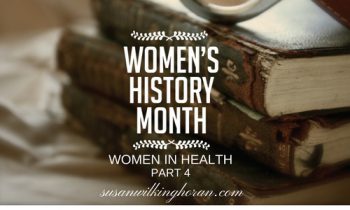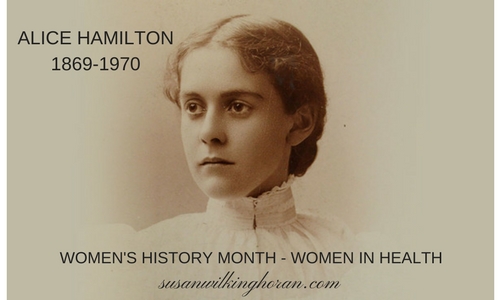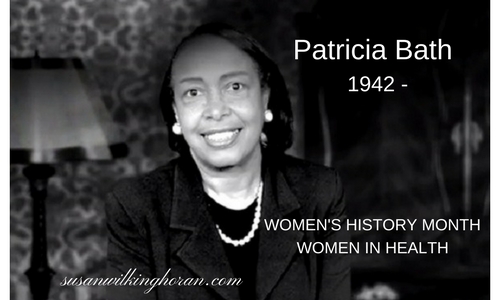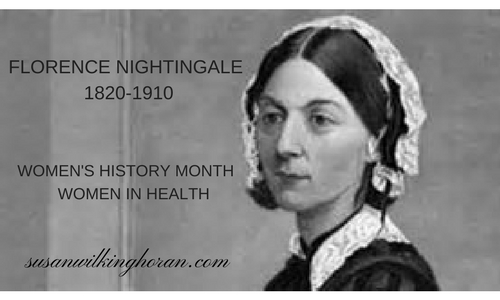 WOMEN IN HISTORY AND HEALTH
WOMEN IN HISTORY AND HEALTH
Hello everyone and welcome back to our final installment of HEROINES OF HEALTHCARE. I’ve had a blast this month honoring twelve amazing women whose contributions and accomplishments helped shape healthcare as we know it today. And now, I’m happy to present the final three women in our Four-Part Series. Please join me and BE INSPIRED!
ALICE HAMILTON
Shortly after the end of the Civil War, Alice Hamilton was born in New York City in 1869. The daughter of a grocer, Alice was determined from an early age to be a socially useful and independent woman.
To accomplish these goals, Alice choose a career in Medicine and was one of a handful of women to earn a Degree in Medicine from the University of Michigan in 1893. She later applied for further studies at the Universities of Munich and Leipzich in Germany – but had to promise to make herself “inconspicuous to male students and professors” as women students were not allowed.
Upon her return to America, Alice became a professor of Pathology at the Women’s Medical School of Northwestern University in Evanston, Illinois and later was appointed as the resident Bacteriologist at the Memorial Institute for Infectious Diseases in Chicago.
It was Alice who discovered the connection between improper sewage disposal and disease transmission by flies. It was she who studied unsafe working conditions and recognized the threat of noxious chemicals, including lead dust, mercury, arsenic and radium. She devoted her life to the betterment of others – establishing medical education classes and “well-baby” clinics at the famous Hull House for the Poor.
Among her many accolades, in 1919 Alice was the first woman to become a professor at Harvard Medical School at a time when Harvard did not even admit female students. She was a pioneer for women’s rights until she died a few months after her 100th birthday. THANK YOU, ALICE HAMILTON!
 PATRICIA BATH
PATRICIA BATH
In 1942, Patricia Era Bath was born in Harlem, New York to the first black motorman for the New York City subway system and a domestic worker. The gift of a chemistry set sparked Patricia’s interest in science and at the age of 16 she was accepted to study at a cancer research workshop sponsored by the National Science Foundation.
Determined to pursue a Medical Degree, Patricia attended Howard University graduating with honors in 1968. She continued her education at Harlem Hospital and Columbia University where she studied ophthalmology. It was here she discovered that African Americans were twice as likely to suffer from blindness and eight times more likely to develop glaucoma than their Caucasian counterparts.
In 1973, Patricia became the first African American to complete a residency in ophthalmology. Two years later, she became the first female faculty member in the Ophthalmology Department of UCLA’s Jules Stein Eye Institute. And, she invented the Laserphaco Probe for cataract treatment, which enabled Patricia to restore the sight of individuals who had been blind for more than thirty years. It also was an invention that made her the first African American female doctor to receive a medical patent.
Patricia developed a community ophthalmology system, which provided eye care to those unable to afford it. She co-founded the American Institute for the Prevention of Blindness, which stated that “eyesight is a basic human right.” And, she helped create and chaired the Ophthalmology Residency Training program at UCLA-Drew, becoming the first woman in America to hold such a position.
As Patricia continues to break the glass ceiling for women everywhere she also continues to teach, study and advocate for telemedicine — the technology which provides medical services for the underprivileged and underserved in remote areas around the world. THANK YOU, PATRICIA BATH!
FLORENCE NIGHTINGALE
Named for her birthplace, Florence Nightingale was born in Florence, Italy, in 1820. She hailed from a prominent and wealthy British family that belonged to all the elite social circles of the day.
In the early 1800s, women had no property rights and as a socialite daughter, Florence was expected to marry a man of means to ensure her class standing. Florence, however, had other plans. She became active in philanthropy at an early age and began ministering to the ill and poor who lived in the villages surrounding her family’s estates.
Against her parents’ wishes, Florence traveled to Germany in 1850 and enrolled as a nursing student at the Institution of Protestant Deaconesses. And, in 1854 Florence organized a corps of nurses to tend the fallen British soldiers of the Crimean War and in doing so became the first female nurse to serve in the war.
Arriving to horrible conditions, Florence quickly went to work cleaning the battlefield hospital, which sat upon a cesspool. She collected scrub brushes, bandages, soap and clean water. She created an “invalid’s kitchen” where nutritious food was served, a laundry to provide clean linens and a library for educational pursuits. She spent every waking minute caring for the soldiers, moving through the dark hallways with a single lamp to light her way. Known as the “Lady with the Lamp,” her dedicated work reduced the hospital’s death rate by two thirds.
Returning to England after the war, Florence used her family money to establish St. Thomas’ Hospital and the Nightingale Training School for Nurses. It was her work and reputation that changed the image of nursing from lowly menial labor to the honorable vocation it is today.
Throughout her life, Florence remained an authority and advocate for healthcare and public sanitation reform – and was a consultant to the United States during the Civil War on field hospital management. She devoted herself to preventing disease, and ensuring safe and compassionate care for the poor and the suffering. THANK YOU, FLORENCE NIGHTINGALE!
___________________________________________________________________________________________________________________________________
And again, THANK YOU everyone for joining me. I’ve really enjoyed shedding light on such amazing women and sharing their stories with you during WOMEN’S HISTORY MONTH. We owe so much to these HEROINES OF HEALTHCARE. For not only did they pave the way for so many women who came after them – but, they helped shape the healthcare system we know today in so many important and valuable ways.
I’ll see you again soon everyone! Until then stay in GOOD HEALTH and . . .
TAKE THE COURSE AND TAKE CHARGE!



Leave a Comment